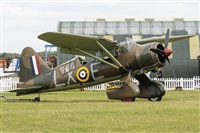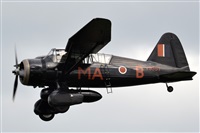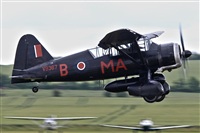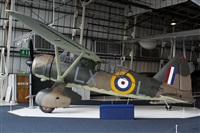 |
|
179 vistas |
|
|
|
|
 |
|
321 vistas |
|
|
|
|
|
|
|
|
|
|
|
|
|
|
Comentarios |
|
Built originally for the RAF as V9552 this aircraft went to Canada in 1942 as a target tug for the RCAF. Post WWII it was sold to a Canadian collector and then, in 1971, went to the Strathallan Collection in Scotland where it was restored to flying condition by late 1979. Grounded in 1986 it was stored, then went Duxford in 1997 for restoration. Purchased by the SVAS it joined the Collection in 1998. It arrived painted in standard RAF camouflage with additional markings to represent No. 309 (Polish) Squadron while operating from bases in Scotland between 1940 and 1942.
In the autumn of 1999, with the aid of a donation from the family of Peter Vaughan Fowler who had flown with 161 Squadron on Lysander operations during World War II, it was repainted in black overall with the markings of his aircraft, bearing the serial V9367. A fixed ladder was installed to allow rapid access to the rear cockpit – as fitted to facilitate picking up agents; a dummy 150 gallon long range fuel tank was attached below the fuselage. In this configuration the Lysander III S.D. (Special Duties) was employed by No. 161 RAF Squadron on clandestine night flying operations from RAF Tempsford and Tangmere between 1942 and 1945
|
|
|
|
|
|
|
|
|
|
|
|
|
|
|
|
|
|
|
|
|
|
Comentarios |
|
|
This Lysander was built in Canada and was used by the RCAF as a target tug serialled 2355. It was bought after the war by Wes Agnew a farmer, former RCAF instructor and collector of aircraft. In 1971 it was purchased by Sir William Roberts for the Strathallan Collection in Scotland. It arrived in the UK in October 1971 and was registered G-AZWT, and work commenced on restoring it. However, it was not until December 1979 that G-AZWT flew again, painted as V9441 a Lysander operated by No.309 (Polish) Squadron. It was grounded in 1986 and was purchased in 1998 by the Shuttleworth Collection. It has been fully restored, repainted and fitted with dummy long range fuel tank and ladder to represent V9367 / MA-B an aircraft of 161 Squadron, flown by Pilot Officer Peter Vaughan-Fowler on operation Apollo during the winter of 1942.
|
|
|
|
|
|
|
|
|
|
|
|
|
|
|
|
|
|
|
|
|
|
Comentarios |
|
|
solo en Duxford se pueden ver estas escenas....
|
|
|
|
|
|
|
|
 |
|
833 vistas |
|
|
|
|
|
|
|
|
|
|
|
|
|
|
|
|
|
|
Comentarios |
|
|
Vista a tres cuartos por detras del Lysander con muchas nubes y poco sol. Algo interesante debe venir por la izquierda, a juzgar por la actitud de los spotters.
|
|
|
|
|
|
|
|
|
|
|
|
|
|
|
|
|
|
|
|
|
|
Comentarios |
|
|
Curiosa perspectiva la que ofrece este Lysander evolucionando en el Flying Legends. Parece tener el ala izquierda mucho más larga que la derecha. La realidad es que este avión tiene una envergadura considerable, como se puede apreciar en el ala izquierda. La derecha, por el diedro y por la perspectiva de la foto, parece ser más pequeña. Por descontado las dos son iguales.
|
|
|
|
|
|
|
|
|
|
|
|
|
|
|
|
|
|
|
|
|
|
Comentarios |
|
|
El Lysander fue muy utilizado en misiones de apoyo a los espías y resistentes franceses durante la IIGM. Sus arriesgadas misiones las acostunbraba hacer de noche(de ahí su pintura negra) en los que volaba a la Francia ocupada trayendo o recogiendo espías o colaboradores franceses y también recogía pilotos aliados derribados que la resistencia francesa mantenía ocultos de los alemanes. Para ello estaba diseñado para realizar aterrizajes y despegues cortos en terrenos mal preparados. Una escalera adosada al lado del fuselaje permitía la rápida subida o bajada de las personas que recogía.
|
|
|
|
|
|
|
|
|
|
|
|
|
|
|
|
|
|
|
|
|
|
Comentarios |
|
|
Configuración de toma del Lysander.
|
|
|
|
|
|
|
|
 |
|
736 vistas |
|
|
|
|
|
|
|
|
|
|
|
|
|
|
|
|
|
|
Comentarios |
|
|
Ala alta y robusto tren de tren de aterrizaje muy adecuados para el avión inglés de enlace por excelencia durante la segunda guerra mundial
|
|
|
|
|
|
|
|
|
|
|
|
|
|
|
|
|
|
|
|
|
|
Comentarios |
|
|
Cuiriosa formación de dos aviones contemporaneos aunque de caracteristicas completamete distintas. El Lysander era un aparato utilitario para cooperación con tierra, famoso por su dificil manejo y el Gloster Gladiator era un caza extremadamente maniobrable.
|
|
|
|
|
|
|
|
|
|
|
|
|
|
|
|
|
|
|
|
|
|
Comentarios |
|
Perteneciente a The Shuttleworth Collection, este modelo fue utilizado durante la IIGM para introducir espias en suelo enemigo, por eso su color negro
Nuevo modelo en AC
|
|
|
|
|
|
|
|
|